by Rajan P. Parrikar
First published on SAWF on March 4, 2002
Part 1 | Part 2
Knowledge of the lakshanas and gestural conduct of the basic ragas is key to understanding the more complex constructions. For the latter are essentially a combination or a subset of the fundamental behaviors, sometimes with a special sangati or two thrown in. From this point on we will tread on the juice and keep the commentary terse.
Raga Din-ki-Pooriya
This raga and Lalit are perhaps the only two major ragas of the Poorvi that to dispense with the pancham. In Lalit the shuddha madhyam provides a peg to hang the melodic hat on whereas in Din-ki-Pooriya there is no such convenience. The swara contour is congruent with Pooriya but with the dhaivat attenuated to the komal shade. The effect is striking and casts a haunting shadow.
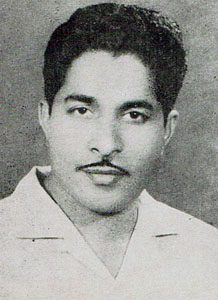
Jitendra Abhisheki
The first clip features an impromptu demonstration by Jitendra Abhisheki recorded at the Kala Academy in Goa. He punctuates the proceedings with pertinent remarks in Konkani and Marathi, in turn expanding on the text of the bandish and the various devices employed in alapchari. The audio quality is sub-optimal but it ought not to detract (unless you are a Dolby weenie).
Mr. Jasraj‘s pedestrian effort fails to realize the latent potential in this melody.
Raga Reva
The pentatonic Reva – S r G P d – is the evening’s ‘jawab‘ to Raga Bibhas of the Bhairav that.
Pandit Ramashreya Jha “Ramrang” explains the relevant bheda and sings a traditional sadra: guna ke grahak Akbar Shah.
Raga Bibhas (Poorvi that)
Recall the lakshanas of Bibhas of the Marwa that. In this Poorvi-that variant the accent is on komal dhaivat and rishab. The affiliation to Poorvi is asserted through clusters such as P m d, P.
This composition chosen by Roshanara Begum is identical to Kesarbai’s in the Marwa-that Bibhas: mora re.
Raga Poorba (Poorvi that)
This uncommon raga preferred by the Atrauli-Jaipur musicians is essentially Raga Poorvi adorned with bells and whistles. A couple of artifacts are grafted on the Poorvi chassis, to wit:
S M, M G P and m, m P, P d, d N d P
The regulation Atrauli-Jaipur bandish, mana ghero, does the rounds.
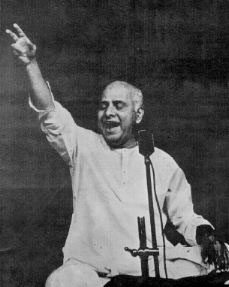
C.R. Vyas
This excerpt of C.R. Vyas is from a tête-à-tête with Ramashreya Jha “Ramrang” held in the mid 1990s in Bombay. In the latter half of the clip, Vyas sings another composition credited to his guru Jagannathbuwa Purohit (‘Gunidas’). The recording of the entire session is deposited in the Appendix at the end of this article.
Raga Triveni
With madhyam dropped the swara-set reduces to S r G P d N. Triveni is known variously as Tirvan and Tirban. It is a Shree-anga raga with attendant emphasis on rishab and special coupling of r and P.
The Shree-like character is evident in this traditional sadra by K.G. Ginde: Kalindi Saraswati.
The same composition is now ambushed by Banditji and his hordes.
Raga Tankeshree (ShreeTanki)
This Shree-anga raga is closely allied to Triveni. Tankeshree is pancham-oriented and takes in the teevra madhyam in alpa pramana (small measure).
Omkarnath Thakur‘s classic: malana la’i.
Raga Malavi (Poorvi that)
No consensus prevails on the swaroopa of this raga.
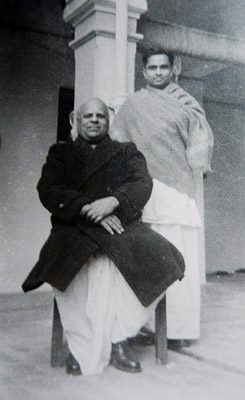
Omkarnath Thakur and Kumar Gandharva
In K.G. Ginde‘s presentation, nishad is rendered alpa in arohatmaka and dhaivat in avarohatmaka movements. Watch out for the G-P, P-G and N-P type of sangatis. This is a composition of S.N. Ratanjankar: namo namo namo Narayana.
The version advanced by Nivruttibuwa Sarnaik takes Pooriya Dhanashree for its base. The shuddha madhyam is introduced strikingly in a special prayoga.
Raga Jaitashree
As the name suggests, the raga is an amalgam of Jait and Shree. The Jait thread is made up of the clusters S G, G P and P-S”-P, and is knitted on the Shree fabric.
Kishori Amonkar illustrates.
Ratanjankar adopts a somewhat different posture in this composition of Bhatkhande (his mudra “Hararang” is stamped in the antara): mhane akeli dara gayo.
The Jait component is even more subtle in the rendition by Abdul Halim Jaffer Khan. The gat is in madhya laya Ada Chautala.
Raga Dhavalshree
No consensus prevails on the raga swaroopa.
Kishori Amonkar‘s version extends Jaitashree by creatively introducing a shuddha dhaivat. Be on the qui vive for the first instance of this D at 0:15: je more saiyyan re.
Mallikarjun Mansur‘s interpretation is another kettle of fish. The S-G-P sangati, a Shree-like r N d P meend and chhayas of Pooriya Dhanashree are evident.
Raga Hamsanarayani
The raga drops the dhaivat. The development is centred around pancham. A sample chalan is suggested:
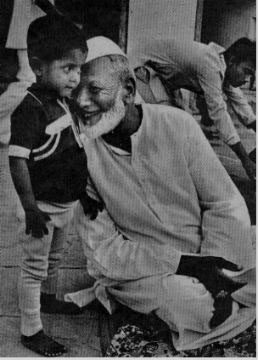
Bismillah Khan with his grandson
G m P, P G m G r S, S P, S S” r” S”, N P, m G, m G r S
Raga Baradi (Poorvi that)
We have encountered varieties of this raga – variously referred to as Barari, Varari and Varati – based in the Marwa that. The Poorvi-that Baradi is aprachalita.
Mallikarjun Mansur‘s version runs a chalan bheda on Pooriya Dhanashree: kaise karun aa’oon re.
Raga Deepak (Poorvi that)
Much mythos is associated with this raga through its pairing with Tansen. We have encountered the Khamaj-that Deepak earlier in In the Khamaj Orchard.
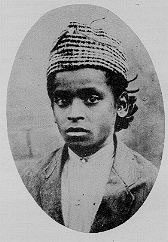
Mallikarjun Mansur
Bhatkhande writes: “…Most musicians will not sing this raga. Even if they venture to sing the purported lakshanas of this raga they will hesitate to associate it with the name ‘Deepak’ out of fear that they will not be believed…” This aptly summarizes Deepak’s station, today all but dead. It is, of course, very likely that many of its features have been absorbed and find expression in other ragas.
We have three clips of the Poorvi-that Deepak. They could well have been branded with three different names.
Jha-sahab outlines the chalan and then an old sadra.
Bundu Khan deploys both madhyams in his dhrupad in Chautala. There’s even a brief avirbhava of Bhairav.
Shujaat Khan‘s version shows influences of Shree. There is a piquant use of the shuddha madhyam. His papa Vilayat perhaps got this “correct,” “authentic,” “true” and “original” Deepak thanks to his seven-generations pedigree that traces it temporal roots to well before the Big Bang.
This concludes our tour of the Poorvi Province.
Other ragas of this that such as Shree, Lalit and Gouri have been addressed in Raga Shree: Close Encounters and On Raga Lalita-Gouri.
Acknowledgements
Many thanks to Romesh Aeri, Ashok Ambardar, Ajay Nerurkar, Guri Singh and Sir Vish Krishnan. Chetan Vinchhi and Sanjay Havanur provided a couple of recordings for this feature. And as always, much credit and gratitude to the tireless Anita Thakur.
Appendix
This impromptu tête-à-tête between Ramashreya Jha “Ramrang” and C.R. Vyas took place in the mid-1990s at the house of Satyasheel Deshpande in Bombay.
Jha-sahab and C.R. Vyas formed a mutual admiration society. Ramrang considered C.R. Vyas to be the “Khalifa of Mumbai.” For his part, C.R. Vyas would think nothing of telephoning Jha-sahab in Allahabad to clarify a finer point or two of a bandish. This is a marvelous document of a meeting of two gifted musical minds.
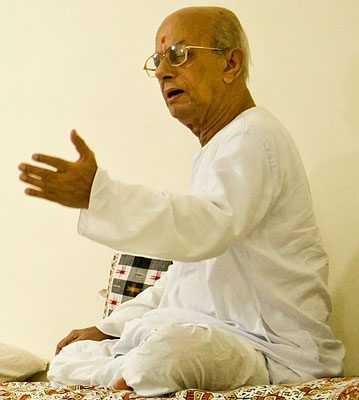
Ramashreya Jha at the author's home in Goa
C.R. Vyas had the utmost regard for Jha-sahab. At one point in the clip, in an uncommon display of honesty for a Hindustani musician of any stature, Vyas confesses to Satyasheel Deshpande (in Marathi) that some aspects of his own training were a case of “the blind leading the blind.” The allusion is to the attitudes of some old gurus who brooked no questions from disciples, treating the subject of music as revealed wisdom beyond the pale of analytical inquiry.
Part 1 | Part 2
